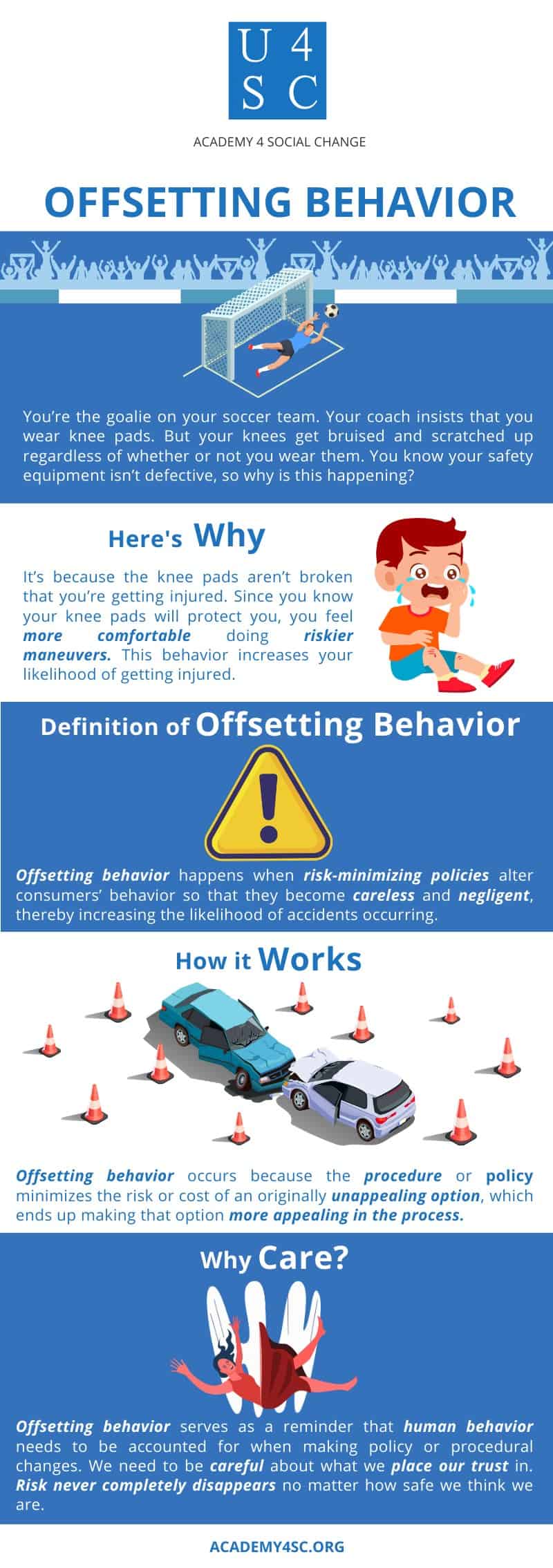Have You Ever?
You’re the goalie on your local soccer team. Whenever you’re on the field, your coach insists that you wear knee pads. “They’ll help prevent your knees from getting injured when you dive for those saves,” he explains. Sometimes you’ll do pickup games with the neighborhood kids, but that’s the only time you’re playing without them on. Weirdly enough, your knees get just as bruised and scratched up regardless of whether or not you wear knee pads. You know your safety equipment isn’t defective, so why is this happening?
Here’s Why
It’s precisely because the knee pads aren’t broken that you’re receiving the same levels of injury. Since you know your knee pads will help protect you, you feel more comfortable doing riskier maneuvers. Doing this riskier behavior increases your likelihood of getting injured. You’ve adjusted your behavior so the benefits of the safety equipment is almost nullified. This is an example of offsetting behavior.
Offsetting Behavior
Offsetting behavior happens when risk-minimizing policies alter consumers’ behavior so that they become careless and negligent, thereby increasing the likelihood of accidents occurring. In other words, offsetting behavior is when a consumer engages in riskier behavior in response to safety policies. Therefore, these safety policies have a much smaller positive effect than one would expect.
How It Works
Offsetting behavior occurs because the procedure or policy minimizes the risk or cost of an originally unappealing option, which ends up making that option more appealing in the process. For example, say that Zoom, a car company, has created a new car model with a built-in “safe driver” feature. This new feature causes the car to stop if its built-in sensors detect something over six inches either in front of or behind the car. This feature should objectively make the car safer and prevent potential accidents from occurring.
Imagine that you bought this Zoom car. You know about its “safe driver” feature - it’s one of the main reasons you bought it. And you do feel a lot safer when you’re driving.
You’re driving the Zoom car to work and you’re running late. Now, you could continue driving the speed limit, thus spending more time on the road and getting a lecture from your boss. Or, you could speed and cut down time spent driving and avoid that nasty lecture. Speeding reduces your ability to see everything on the road and brake in time for an emergency. But wait! You’ve got that fancy “safe driver” feature that will stop if you come across something.
It seems pretty tempting to speed up, doesn’t it?
However, the built-in sensors aren’t perfect: neither can they detect anything on the sides of the car, nor can they detect anything under six inches tall. Furthermore, sometimes the braking system might just fail. Reducing your ability to see and react to road changes increases the likelihood of car accidents, thereby reducing or even nullifying the positive effects of Zoom’s safety feature. The safety measure makes people more comfortable with performing risky behavior, which in turn decreases their overall safety.
Why Care?
Offsetting behavior serves as a great reminder that human behavior needs to be accounted for when making policy or procedural changes. A safety feature can work exactly as it was designed to, and still have a meager effect on the public’s overall safety.
Furthermore, we need to be careful about what we place our trust in. Engaging in risky behavior increases the chance of accidents and injuries occurring, no matter how safe we think performing that behavior is. Risk never completely disappears. Regardless of our interests, we need to be aware of offsetting behavior so that we can minimize its influence. Otherwise, we might find ourselves expecting a safety net when there is none.



